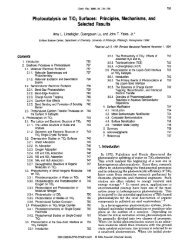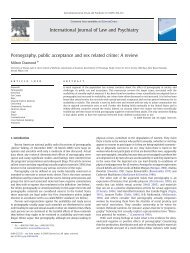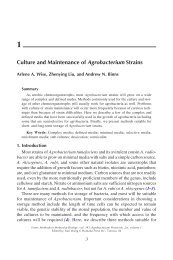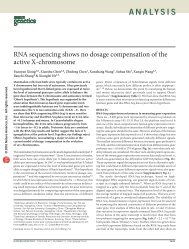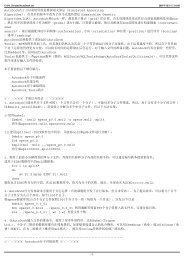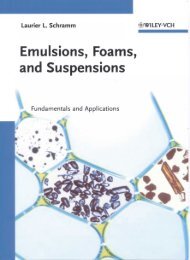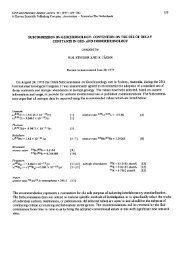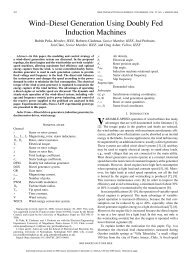Create successful ePaper yourself
Turn your PDF publications into a flip-book with our unique Google optimized e-Paper software.
Cell<br />
360<br />
after the activated T cells accomplish their task, they<br />
must be removed to avoid accumulation. Mature T cells<br />
from lpr or gld mice do not die after activation, and<br />
activated cells accumulate in the lymph nodes and<br />
spleens of these mice. When T cell hybridomas are activated<br />
in the presence of a Fas-neutralizing molecule,<br />
they do not die. These results indicate that Fas is involved<br />
in activation-induced suicide of T cells, i.e., in<br />
down-regulation of the immune reaction (Figure 3A) (Nagata<br />
and Golstein, 1995). Peripheral clonal deletion may<br />
also be mediated <strong>by</strong> the Fas system, because the cells<br />
to be deleted in this process are activated <strong>by</strong> interactions<br />
with cells expressing self antigens. However, thymic<br />
clonal deletion is apparently normal in mice lacking<br />
the functional Fas system (lpr-, gld-, or Fas-null mice)<br />
(Singer and Abbas, 1994), even though thymocytes<br />
abundantly express Fas and are sensitive to Fasinduced<br />
apoptosis. These results suggest that Fas is<br />
not involved in the deletion process in the thymus, although<br />
one cannot rule out the possibility that this process<br />
is mediated <strong>by</strong> redundant mechanisms.<br />
In addition to T cells, the Fas-deficient mice accumulate<br />
B cells and have elevated levels of immunoglobulins<br />
Figure 2. When <strong>Apoptosis</strong> Fails<br />
of various classes that include anti-ssDNA and anti-<br />
Wild-type (�/�) and Fas-null (�/�) mice were killed at 16 weeks of<br />
age, and their lymph nodes (LN) and spleen (SP) are shown (from dsDNA antibodies (Cohen and Eisenberg, 1991), sug-<br />
Adachi et al., 1995).<br />
gesting an involvement of the Fas system in the deletion<br />
of activated or autoreactive B lymphocytes. In fact, immunization<br />
of mice with antigens rapidly induces Fas<br />
in the thymus, liver, heart, and kidney. On the other expression in germinal centers. Furthermore, the actihand,<br />
FasL is predominantly expressed in activated T vation of naive B cells through CD40 sensitizes them<br />
lymphocytes and Natural Killer (NK) cells, although it to Fas-mediated apoptosis, while their costimulation<br />
is also expressed constitutively in the tissues of the through CD40 and Ig receptor makes them resistant<br />
“immune-privilege sites” such as the testis and eye, as (Rothstein et al., 1995). Although these results suggest<br />
described below. The mouse mutations, lpr (lympho- that FasL-expressing T cells kill the Fas-expressing actiproliferation)<br />
and gld (generalized lymphoproliferative vated B cells, the precise mechanism and physiological<br />
disease), are spontaneous recessive mutations (Cohen role of Fas in the deletion of B cells remains to be<br />
and Eisenberg, 1991). Mice carrying homozygous muta- studied.<br />
tions in lpr or gld develop lymphadenopathy and spleno- Children carrying a defect in the Fas gene have also<br />
megaly <strong>by</strong> accumulating CD4�CD8� cells of T cell origin, been identified (Fisher et al., 1995; Rieux-Laucat et al.,<br />
and some strains of mice develop autoimmune dis- 1995). Most of these patients carry a heterozygous mueases.<br />
Genetic and molecular analyses of lpr and gld tation in the Fas gene. The affected Fas protein seems<br />
mutations showed that they are loss-of-function muta- to work in a dominant-negative fashion, and T cells from<br />
tions in the Fas and FasL genes, respectively (Wata- the patients do not die upon activation. The patients<br />
nabe-Fukunaga et al., 1992; Takahashi et al., 1994). The show phenotypes (ALPS, autoimmune lymphoprolifera-<br />
Fas-null mice, established <strong>by</strong> gene targeting (Adachi et tive syndrome) that are remarkably similar to those of lpr<br />
al., 1995), also show lymphadenopathy and splenomeg- mice, including lymphadenopathy, splenomegaly, and<br />
aly (Figure 2), which is much more pronounced than in hypergammaglobulinemia. Some patients show autoimmice<br />
carrying the leaky lpr mutation. Furthermore, when mune diseases such as hemolytic anemia, thrombocyto-<br />
Fas was expressed in the lymphocytes of lpr mice as a penia, and neutropenia <strong>by</strong> producing autoantibodies<br />
transgene, the lymphoproliferative phenotype was res- against red blood cells and platelets. On the other hand,<br />
cued (Wu et al., 1994), confirming that Fas plays a role the fathers or mothers of the patients, who also carry<br />
in the programmed cell death of T lymphocytes. the heterozygous mutation of the Fas gene, do not show<br />
T lymphocytes, which are responsible for removing an abnormal phenotype, suggesting that the patients<br />
virally infected and cancerous cells, die at various carry mutations in other complementing genes. Alternastages<br />
of their development. Most immature T cells are tively, Fas could be required only for the perinatal period,<br />
useless (incorrect rearrangement of the T cell receptor) and the parents may also have had a similar phenotype<br />
or potentially detrimental (self-reactive) to the organism. in childhood that was rescued later, since the heterozy-<br />
More than 95% of thymocytes that immigrate into the gous mutation is leaky.<br />
thymus are eliminated <strong>by</strong> positive and negative selection Effector of Cytotoxic T Lymphocytes<br />
during their development. In the periphery, mature T and Natural Killer Cells<br />
cells that recognize self antigens are also deleted (pe- Cytotoxic T lymphocytes (CTL) recognize and kill cells<br />
ripheral clonal deletion). When mature T cells encounter infected <strong>by</strong> viruses or bacteria, while NK cells kill cancerous<br />
cells. The professional CTL are CD8� target cells, they are activated to proliferate. However,<br />
T cells, but





